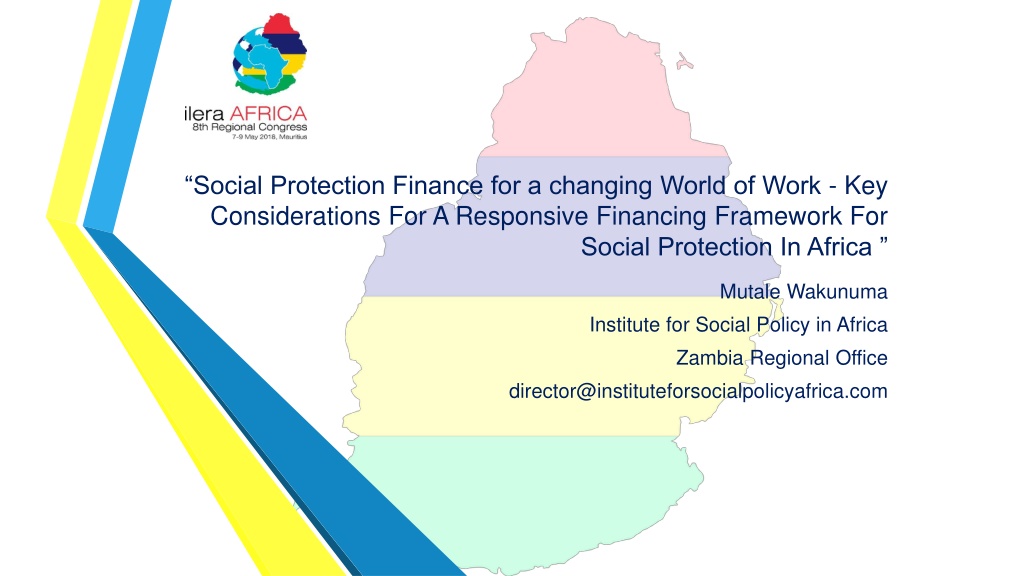Social Protection Financing in Africa: Key Considerations for a Changing World
Understanding the current landscape of social protection financing in Africa is crucial for addressing challenges such as poverty, inequality, and unemployment. With low social protection coverage and dependency on donor funding, a responsive financing framework is needed to ensure sustainable development and improved well-being for the region's population.
Download Presentation

Please find below an Image/Link to download the presentation.
The content on the website is provided AS IS for your information and personal use only. It may not be sold, licensed, or shared on other websites without obtaining consent from the author. Download presentation by click this link. If you encounter any issues during the download, it is possible that the publisher has removed the file from their server.
E N D
Presentation Transcript
Social Protection Finance for a changing World of Work - Key Considerations For A Responsive Financing Framework For Social Protection In Africa Mutale Wakunuma Institute for Social Policy in Africa Zambia Regional Office director@instituteforsocialpolicyafrica.com
Outline 01 Contextual Overview 02 Social Protection in the Region 03 Current SP Financing Architecture 04 African Social Protection Context and the future of work 05 What the future should look like
Contextual Overview Population: 334,166,067 Regional GDP (Simple average): 38,28 $bn (2016) GDP Per Capita: 1,761$ Gini coefficient: 0.55 Poverty: 43% (2012) Country GDP USD bn Year Angola 89,63 2016 Botswana 15,27 2016 D. R. Congo 35 2016 Lesotho 2,2 2016 Madagascar 9,991 2016 Malawi 5,442 2016 Mauritius 12,16 2016 Mozambique 11,01 2016 SADC Countries GDP Namibia 10,27 2016 350 2500 300 South Africa 2000 294,8 2016 250 1500 Swaziland 200 3,727 2016 150 1000 Seychelles 1,427 2016 100 500 50 Tanzania 47,43 2016 0 0 Zambia 19,55 2016 Zimbabwe 16,29 2016 GDP USD bn Year
Poverty and Inequality POVERTY & INEQUALITY Differences between Countries are significant
Employment High levels of unemployment High levels of informal activity (often more than 90% of the workforce) Mostly labour intensive High levels of illiteracy Highly unskilled labour force
Social Protection in the Region Characterised by low levels of social protection coverage (6%-20%) Contributory social security coverage (5%) Spending on social protection is typically in the region 1.6 % of GDP. Dominant programming is Agricultural subsidy, Cash Tran sfers and School feeding Response to poverty and vulnerability and lately inequality Still fairly dependent on donor funding
The Current Social Protection Financing Architecture Historical Perspective, 0.7% of GNI Price Tag for Sustainable Development 5 to 7 trillion, deficit 2.5 trillion Challenges with ODA for Social Protection in the SDG Dispensation (peak of $142.6 billion in 2016) World Bank estimated that between 50 and 80 percent of what s required will come from domestic resources. Blended Finance Social good versus profit
How much do countries spend on SP? Simple mean of GDP allocated to SP: On average, 11%. Weighted by population: 8.4 per cent of the GDP. In SSA? 1.7% of GDP on average to non- contributory
Current Financing Picture Where it gets Interesting Banking on Blended Finance and Domestic Resources ODA Domestic Resources Minimally Investing in Social Protection and Banking on ODA
The African Social Protection Context and the future of work 02 03 01 Social Protection Employment still largely Informal Financing Employment Social Protection coverage challenges Financing Gap hugely unresolved
Key Considerations for a responsive Social Protection System for the Future of Work Data Systems Fiscal Space Expansion Earmarked taxes or through taxation of natural resource Data systems will be pivotal to the identification of Social Protection Needs and policy design extraction Benefit Portability Domestic Resourcing Regulations should be modified and simplified to address t he challenges from changes in work. Sustainability through increased levels of domestic finan cing and Legislation Rethinking Tax Restructuring Education Education system and skills development as a core ele ment of Social Protection provision Reducing tax reliance on low income earners and curbing tax competition
Thats it! Thank you for your Attention

 undefined
undefined
























